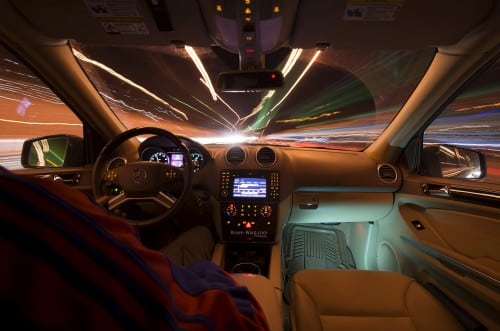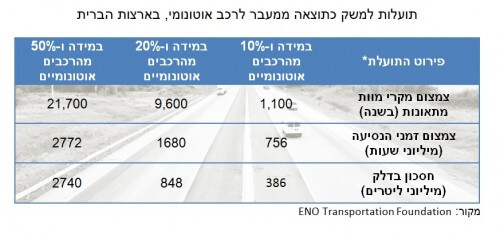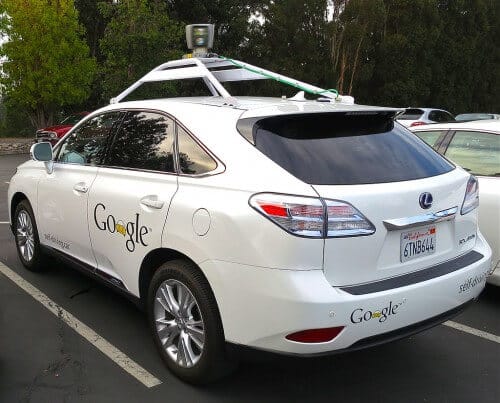Today, several companies are simultaneously developing automatic vehicles without the need for a driver, and experts estimate that they will appear on Israeli roads as early as 2050. How will these vehicles affect traffic accidents, traffic jams and our fuel consumption? About all this in the article in front of you
Assaf Ben Naria - Angle - Science and Environment News Agency

Many of us may not attach much importance to October 21, 2015. But for the children of the eighties it is a holiday - it is the day when Marty (Michael J. Fox) and Doc (Christopher Lloyd), the stars of the film series "Back to the Future", arrived in the future . For those who need a reminder, the two arrive in an upgraded DeLorean vehicle to a futuristic world where there is no need for roads, because the cars fly in the air; And there's no need for fuel either - simply throw the leftover food into the compartment in the back of the vehicle, where it turns into fuel.
Today it is clear that the transportation reality has not turned in the direction presented in "Back to the Future", and unfortunately, remains very similar to how it looked in the 2050s. Flying cars can still only be seen in movies, and even fuel produced from biomass - organic material derived from plants or animals - still does not power our vehicles. On the other hand, in other aspects of transportation, it seems that the future is already here. Today, several companies are simultaneously developing automatic vehicles without the need for a driver, and experts estimate that they will appear on Israeli roads as early as XNUMX. How will these vehicles affect traffic accidents, traffic jams and our fuel consumption? About all this in the article in front of you.
Reduced fuel consumption
Autonomous vehicles have made headlines recently following the entry of large commercial companies, such as Google and Ford, into the race to develop an autonomous vehicle without a driver. The vehicles of the future guarantee a reduction in accidents of the human factor type, thanks to the introduction of advanced control and sensing systems, some of which already exist in the market (among them the one of the Israeli Mobileye). According to data from the Central Bureau of Statistics, 78 percent of road accidents in Israel in 2013 were caused by the driver's fault. The latest reports on accidents involving Google's experimental vehicle also raise doubts about the safety of autonomous vehicles, but according to the search giant, the fault in all accidents was the offending vehicle (mostly curious that the shock from the futuristic vehicle took them away from reality for a moment and brought them a little too close to meeting the vehicle in front of them) .
The autonomous vehicles will not run a red light and, without a driver, there will be no one to fall asleep at the wheel late at night. The smart transportation systems in vehicles are expected to reduce traffic jams that originate from human behavior, and in addition, the vehicles will communicate with each other and be updated in real time on the traffic situation. Accordingly, they will choose the best way, which will serve us all for the common goal: to reach the destination in the shortest time.
The environmental benefits guaranteed by the autonomous vehicle, apart from the reduction of traffic accidents, are reduced fuel consumption as a result of smoother driving and reduced road congestion. Today, every vehicle on the road occupies a space much larger than its actual size in order to maintain a distance from the vehicle in front of it, which is essential considering the human reaction time. The autonomous vehicles are expected to increase the volume of vehicles that a given road can accommodate by reducing the distance between the vehicles. The environmental benefits will be significantly greater if the autonomous vehicle is also electric, and this is where the industry is headed.
In several states in the United States, as of today, laws have been approved that allow the travel of autonomous vehicles without a driver, and until June 2015, Google's test vehicles alone had accumulated more than a million miles of asphalt. Conservative estimates say that we will all be driving an autonomous vehicle without a driver by the middle of this century. Less conservative estimates say that by 2020 we will already see many driverless vehicles on the road.
Benefits to the economy as a result of switching to an autonomous vehicle

A new transportation catastrophe
So far sounds ideal; But various experts from the fields of transportation and the environment fear that the convenience, availability and the fact that the operation of the autonomous vehicle will not require special skills (nor a reasonable level of alcohol in the blood) will lead to an increase in the number of trips and at the same time will make the alternative - public transportation, bicycles or walking - less in demand.
According to Prof. Yoram Shiptan from the Transportation Research Institute at the Technion's Faculty of Civil and Environmental Engineering, with the advent of autonomous vehicles we should expect two phenomena to occur simultaneously. "People will travel more frequently and for greater distances, and at the same time travel will be more efficient in terms of the resources required," he explains. Thus, the question of whether the current transportation revolution will have a positive effect on the environment or not will depend on the policy makers; They will have an important role in ensuring that the transition to autonomous vehicles does not lead to more trips, and what could develop into a new transportation catastrophe.
To illustrate, Shiptan indicates a possible situation in which, out of a desire to avoid paying an expensive price for parking in the city center, the owner of the autonomous vehicle will send the vehicle to park at home and at the end of the day call it back, thus effectively doubling the travel distance. According to Shiptan, the policy should combat exactly such situations, "already today, by setting levies and traffic restrictions". The safest way to ensure that the transition to autonomous vehicles will be characterized by a positive impact on the environment is to make the vehicle shared and the trips shared, and to send the vehicle to additional collection tasks while its owner is at work, for example. "This will be the real revolution", he concludes.
Smart service taxi
In the cooperative vehicle model, known internationally as Car-Sharing, instead of owning the vehicle, the user acquires the right to use it for short periods of time. In a car pooling model, several passengers share the same trip or parts of it. A combination of the two approaches, shared vehicle and shared travel, allows for a reduction in the number of vehicles on the road and a reduction in the number of parking spaces required to less than ten percent of the current amount. Experts from the field of transportation predict that the autonomous vehicle will make the vision of the collaborative vehicle and the shared ride possible, since one of the barriers today is the accessibility of the vehicles to the driver. When the vehicle can drive itself to the driver, it will be possible to overcome the accessibility barrier.
In Stockholm, a study examined the possibility of collecting a number of passengers in the shared autonomous vehicle, which would turn it into a kind of autonomous and smart service taxi. The study indicated that this move would indeed increase the average travel time by 15 percent and the waiting time by ten minutes, but would result in a significant reduction in the cumulative travel range and the number of vehicles on the road. Such a move will lead to a significant decrease in air pollution originating from transportation. In the magazine NATURE Climate Change, a study was published that showed that with autonomous and electric cooperative transportation it is possible to reduce the pollution caused by transportation by 94 percent compared to the situation that exists today!

Israel 2050
In order to assess how we will get around in the coming years, a study was carried out in Prof. Shiptan's laboratory that examined what Israeli experts from the field of transportation think about the future of the car. In the study, which was carried out as part of the work of Reot Ben-Haim, the experts were required to estimate the probability that various vehicle technologies that are being developed today will penetrate our lives by the year 2050. The results showed that compared to other technologies, regarding the autonomous vehicle, the experts are a little more skeptical - only 61 percent of them believe that driverless vehicles will appear on Israeli roads in 2050.
However, it seems that we are at the threshold of another revolution, and like many products that at first seemed imaginary (the smart phone for example), the autonomous vehicle will, sooner or later, become common in our districts. The impact that the autonomous car will have on the environment depends to a large extent on our ability to wean ourselves from the addiction to the private car. If the results of the revolution of autonomous vehicles will be similar to what the private car went through in the middle of the 20th century, i.e. many more vehicles on the road, not only will the problems of traffic jams and air pollution not be solved, it can be expected that they will only worsen.
More of the topic in Hayadan:

8 תגובות
I don't like the idea of a shared car at all, with all due respect many times I want to drive in a car alone, quietly without distractions around and without people talking next to me and confusing my mind, I don't want a car that is a taxi.
"Experts estimate that they will appear on Israeli roads as early as 2050"
In my opinion it will be very sad if they appear on the roads *only* in 2050, in my opinion it will happen much earlier according to the rate of technological development. Think about it right now the first models of autonomous vehicles (eg Google's) are making their way on the roads, I don't think we will need another 35 years for this field to mature.
Think exponentially.
This video is indeed fabricated, but there was a video about a real intersection without traffic lights where the traffic flows and without any accidents, if I find it I will give a link.
"Even at intersections, the autonomous cars will not need a cumbersome system of traffic lights to schedule the use of the intersection and will simply be able to schedule their passage and weave the traffic of the cars traveling in the different directions"
Loram reminded me of this video 🙂
https://www.youtube.com/watch?v=foeklDLcacI
Once a critical mass of autonomous vehicles with vehicle-to-vehicle communication is created, they will be able to take advantage of their advantages. Keeping a minimal distance between autonomous vehicles in traffic will allow them to chain themselves into huge chains that move at the speed of the first vehicle and simply slice through the traffic. No human driver will be able to fit into such a column that travels at a speed of 90 km/h when the distance between the cars in it is half a meter. Even at intersections, the autonomous cars will not need a cumbersome system of traffic lights to schedule the use of the intersection and will simply be able to schedule their passage and weave the traffic of the cars traveling in the different directions. A human driver will no longer be able to integrate into it, and there will be less need for expensive and wasteful replacements in the territories. When these advantages become apparent and the enormous savings achieved by autonomous cars during rush hour become clear, human driving will no longer seem so tempting. At first it will remain for the poor, but they too will get second-hand cars and eventually there will be a wave of public outrage at all the morons who insist on holding up traffic with their eccentric driving habits, and will limit them to cars colliding at an amusement park..
In theory everything is fine, in reality drivers will take advantage of the right of way that the automatic vehicle gives and push through traffic jams or cut lanes. An automated vehicle will not work well when it is traveling together with a human environment that tries to take advantage of it.
And don't tell me there won't be more human drivers. There will always be motorcycles or just those who enjoy driving.
If such a vehicle hits a person, who is considered guilty?
Isn't 2050 another 35 years??
Let's exaggerate a little more...